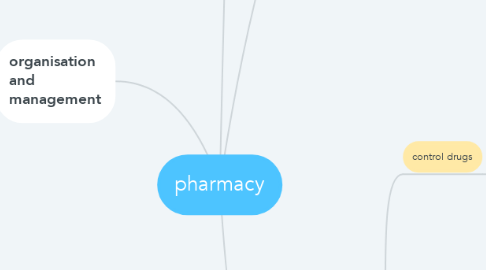
1. organisation and management
1.1. drugs zealing bag
1.1.1. with different sizes
1.1.1.1. big
1.1.1.2. medium
1.1.1.3. small
1.2. drugs
1.2.1. pills
1.2.1.1. antibiotics
1.2.1.2. anti-diarrheal
1.2.1.3. antiparasites
1.2.1.4. analgesia
1.2.1.5. gastrointestinal
1.2.1.6. antiepileptics
1.2.1.7. neurological
1.2.1.8. cadiovascular
1.2.1.9. respiratory&urinary
1.2.2. injections
1.2.2.1. neurological
1.2.2.1.1. opoids(analgesia)
1.2.2.1.2. anaesthesia
1.2.2.1.3. sedatives
1.2.2.1.4. antidepressent
1.2.2.1.5. antiepileptics
1.2.3. topical drugs
1.2.3.1. ears
1.2.3.1.1. antibacterial/antibiotics
1.2.3.1.2. antifungal
1.2.3.1.3. antiseborrhoeics
1.2.3.1.4. antihestimates
1.2.3.2. skin
1.2.3.3. eyes
1.2.3.3.1. mydriates&miotics
1.2.3.3.2. carvonic anhydrase inhibitors
1.2.4. controlled drugs
1.2.4.1. tramadol
1.2.4.2. ketamine
1.2.4.3. Buprenorphine
1.2.4.4. cabinets
1.3. labels
1.3.1. some clinics write
1.3.2. some clinics type
1.4. administration of medications
1.4.1. right animal
1.4.1.1. cats
1.4.1.2. dogs
1.4.1.3. other exotics
1.4.2. right doses
1.4.2.1. double calculate with the vet/ senior nurse
1.4.3. right drug
1.4.3.1. double check with the vet/ senior vet nurse
1.4.4. right time
1.4.4.1. SID
1.4.4.2. BID
1.4.4.3. TID
1.4.4.4. QID
1.4.4.5. o.d.
1.4.4.6. e.o.d.
1.4.4.7. as needed
1.4.5. right route
1.4.5.1. oral
1.4.5.2. intramuscular
1.4.5.3. subcutaneous
1.4.5.4. intravenous
2. methods of communications
2.1. between staff
2.1.1. whiteboard
2.1.2. email
2.1.3. telephones
2.1.3.1. connect with reception
2.1.3.2. connect with consultation room
2.1.3.3. connect with surgery theater
2.1.4. paper work
2.1.4.1. documentation
2.1.4.1.1. Control drugs records
2.1.5. notebook
2.1.5.1. inventory in&out
2.2. between clients
2.2.1. telephones
2.2.1.1. drugs dispensing
2.2.1.2. asking for patients condition
2.2.1.3. questioning about drugs
2.2.2. emails
2.2.2.1. dispensing
2.2.2.2. questioning about drugs
2.3. others
2.3.1. email
2.3.1.1. ask for inventory
2.3.2. telephone
2.3.2.1. order goods
3. management of staff
3.1. Vet Nurses
3.1.1. not being trained
3.1.1.1. encourage them to attend more courses
3.1.1.2. encourage them to read more books about veterinary pharmacy
3.1.2. has been trained--> is qualified
3.1.2.1. can be the leader to lead probation nurses&trainees
3.1.2.1.1. can teach and explain to the new staff
3.1.2.1.2. to educate them
3.1.2.2. they know clearly about the clinic's process
3.2. staff training
3.2.1. vets can educate the VNs&encourage them to read/research more about pharmacy
3.2.1.1. uses of drugs
3.2.1.2. side effects
3.2.1.3. types
3.2.1.4. combination use
3.2.2. workshop about veterinary pharmacy
4. legislations
4.1. control drugs
4.1.1. must be recorded down
4.1.1.1. notebook
4.1.1.2. computer
4.1.2. should be strictly managed
4.1.3. always ask the vet before dispensing drugs
4.1.3.1. get the approval
4.1.3.2. vet is responsibly to dispense drugs
4.2. sharpbox
4.2.1. injection bottles
4.2.2. needles
4.2.3. glass
4.3. health and safety
4.3.1. wear gloves when handling drugs
4.3.2. always check expiry date before use
4.3.3. wear mask&goggles when handling powders
4.4. always focus on Veterinary Medicine Regulations
4.4.1. including their manufacture, advertising, marketing, supply and administration
4.5. Misuse of Drugs Act 1971
4.6. Misuse of Drugs Regulations 1985
4.7. Health and Safety at Work Act 1974
4.7.1. covering occupational health and safety

